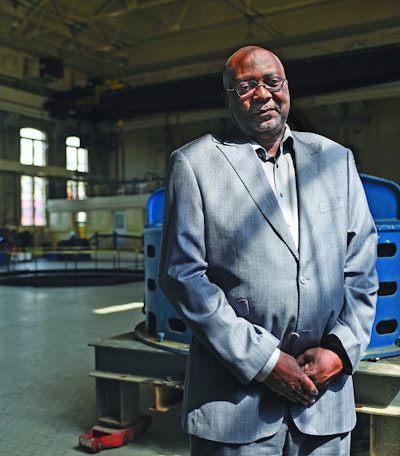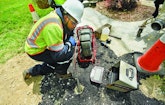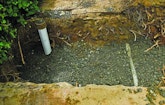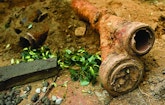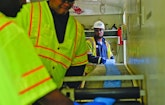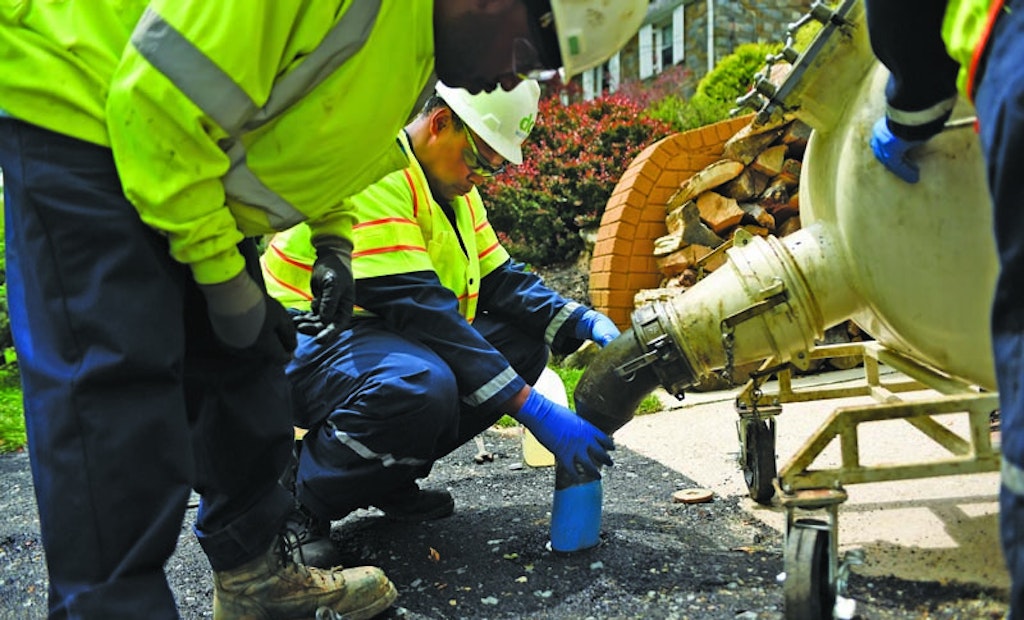Interested in Infrastructure?
Get Infrastructure articles, news and videos right in your inbox! Sign up now.
Infrastructure + Get AlertsTrenchless technology and in-house expertise are enabling DC Water to reline and repair sewer laterals at a fraction of the cost of the open-cut approach.
According to Muminu Badmus, DC Water’s acting manager of sewer construction and repair, the utility is using its own crews to replace more than 100 laterals a year with CIPP liner technology and is realizing a savings of $1 million or more per year over conventional excavation methods. The cost of replacing a typical 25-foot lateral with CIPP technology is running about one-third the cost of open cut, he reported in a presentation last February at the Pumper & Cleaner Environmental Expo International in Indianapolis.
“The average cost of a single lateral replacement so far is about $3,900 – or a $7,300 savings over open cut,” he says. CIPP not only seals openings in the pipe walls, preventing infiltration and root intrusion, it also eliminates surface disruption and restoration. “As we expand the use of CIPP, we anticipate an annual savings of $2.9 million in capital spending based on the current replacement rate,” Badmus says.
Old system
The DC Water sewer system is about as old as it gets with some pipes dating back to before the Civil War, and construction materials including everything from brick to vitrified clay to cast iron to concrete. “We still find wood in some of the pipes in older sections of the city,” Badmus says.
More than 630,000 residential, commercial and governmental customers in the District of Columbia receive wastewater collection and treatment services from the utility, which also provides wholesale wastewater treatment for about 1.6 million people in neighboring counties outside the District in Maryland and Virginia.
The DC Water collection system consists of 1,800 miles of sanitary and combined sewers, 22 flow-metering stations, nine offsite wastewater pumping stations and 25,000 catch basins. The sewers range from 8-inch pipelines to 27-foot arches. About two-thirds of the system is separated, with combined sewers carrying both sanitary and stormwater in the downtown and other older sections of the service area.
The utility’s Blue Plains Advanced Wastewater Treatment Plant provides wastewater treatment. Designed for an average daily flow of 370 million gallons, it is the largest advanced wastewater treatment facility in the world.
Laterals
As in most cities, DC Water’s customers are responsible for the portion of the sewer lateral on their property, while maintenance of the lateral from the sewer to the property line is the responsibility of DC Water’s department of sewer services. There are 150,000 laterals in the service area, typically 4-inch pipes running 5 to 100 feet in length.
For decades, the department has used open-cut replacement methods to maintain the integrity of its laterals. This approach resulted in significant costs to restore the surfaces and roadways that were disrupted by the process – to say nothing of the inconvenience to customers, Badmus says.
In DC Water’s experience, contractors may need as many as four days and up to six workers to complete an open-cut replacement at a cost of about $11,500 including surface restoration.
Then, in 2011, the approach changed.
“We visited a CIPP demonstration in Maryland,” Badmus recalls. The DC Water sewer team liked what it saw and came back and recommended to the utility’s management that trenchless technology was the right choice for DC Water’s lateral replacement program.
After careful review, the utility selected the CIPP process offered by Perma-Liner Industries, purchased the necessary equipment, and trained an in-house crew of four employees (see sidebar).
About 80 percent of the DC Water lateral system lends itself to CIPP, with the other 20 percent of the lines requiring open-cut restoration because they are completely collapsed, or contain 90-degree bends. For these excavations, DC Water uses outside contractors.
In 2012, the first year of the project, the utility was able to rehabilitate about 100 laterals using CIPP. In 2013, the utility completed 130 rehabilitations, and as of spring 2014, another 100 had been completed. The number of jobs completed often depends on whether a new clean-out is required.
Working out of a trailer housing the compressor, the CIPP inverter and a root cutter, the liner crew first inspects the lateral using CUES CCTV equipment. The camera is directed through the line to assess the condition and the material type and determine if the line is a good candidate for CIPP.
If it is, the crew uses a small jetter (US Jetting) to clean the lateral of debris and cut any roots that may have intruded into the line. The CIPP process uses a PVC coated liner impregnated with liquid resin. A roller applies a uniform coating of resin inside the liner. Then the liner is inserted into the lateral through a Y-connector at the clean-out, using the inverter. The liner is pushed through the lateral by air pressure, which unfolds the liner inside the pipe and fully inflates it to the desired diameter, forcing the saturated lining against the inside lateral wall. The resin cures in a few hours.
Badmus explains that DC Water is using ambient air and temperature conditions to cure the liner rather than steam. “It’s taking us a bit longer [up to three hours to cure], but until we get more experience with the technology, we had some safety concerns with steam,” he says.
The finished product is worth the wait. “Once the process is done, the inner pipe wall is smooth and seamless and has an expected life span of 50 years,” Badmus says.
Replacement of a lateral with the CIPP approach usually takes just one day on the job, Badmus explains, and if the properties have existing clean-outs and are in close proximity, it’s possible to accomplish two to three lateral replacements in a single day.
Normally, though, installing a clean-out is necessary before the lining can take place. “Most locations don’t have a clean-out,” Badmus says, explaining that his crews use a backhoe to make the new clean-outs wide enough.
Good results
Now in the third year of the CIPP lateral lining project, DC Water is convinced it made the right decision. Badmus has been calculating the savings over open cut and reports saving $900,000 in 2012, $1.5 million in 2013, and over $700,000 just a few months into the 2014 construction season.
Customer satisfaction is another benefit. “Our customers love it,” Badmus says of the liner approach. “Not only are we saving money, we get in and get out. There’s no mess, no construction, no traffic controls.
“CIPP is working well for us,” he says. “We are talking to our board of directors about the need to do more – to add another trailer and perhaps double our savings [going forward].”
That’s the goal. Badmus says his department would like to get the additional trailer and be able to add more four-person crews to achieve even more savings.
He says his department envisions pushing the trenchless approach to the point of doing 400 or more replacements a year using CIPP.
Reaching that level will require more personnel. “We need to train more people,” Badmus says, noting that with a small crew, an employee sick day or other absence can disrupt the schedule. Turnover can have a negative impact, as well.
One approach might be to pull more people from traditional work to do the clean-outs, freeing up the lining teams to concentrate on lateral replacement.
Badmus is optimistic. “We’re not where we want to be just yet,” he says. But at the end of his presentation at the Pumper & Cleaner Expo, he concluded:
“Imagine spending 65 percent less for the cost of a replacement or installing 182 percent more at the same funding level simply by working smarter. All our investment decisions should be that easy.”
More Information
Perma-Liner Industries, LLC - 866/336-2568 - www.perma-liner.com
US Jetting, LLC - 800/538-8464 - www.usjetting.com
